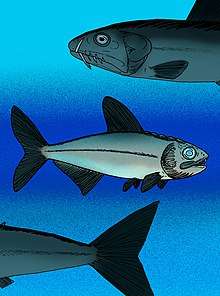Veridagon
Veridagon avendanoi is an extinct aulopiform ray-finned fish related to species of Enchodus from the Cenomanian-aged Cintalapa Formation, exposed in El Chango Quarry, Chiapas, Mexico. Its original generic name was Dagon; however, this name was preoccupied by a group of South American butterflies. The generic name was eventually amended to Veridagon.[2]
| Veridagon | |
|---|---|
 | |
| V. avendanoi as compared to Enchodus | |
| Scientific classification | |
| Kingdom: | |
| Phylum: | |
| Class: | |
| Subclass: | |
| Order: | |
| Suborder: | Aleposauroidei |
| Family: | †Enchodontidae |
| Genus: | Veridagon |
| Binomial name | |
| Veridagon avendanoi Díaz Cruz et al. 2019[1] | |
Etymology
The original generic name refers to both the fish god of the Philistines, and the Lovecraft character. The amended generic name has the added suffix "veri," derived from the Latin, verus, meaning "true" or "real."[2]
Appearance
The holotype and only specimen is 220 millimetres (8.7 in) long. It depicts a fusiform animal similar in anatomy to Enchodus, with a series of small dorsally placed plates on the roof of its head.
References
- Jesús Alberto Díaz-Cruz; Jesús Alvarado-Ortega; Gerardo Carbot-Chanona (2019). "Dagon avendanoi gen. and sp. nov., an Early Cenomanian Enchodontidae (Aulopiformes) fish from the El Chango quarry, Chiapas, southeastern Mexico". Journal of South American Earth Sciences. 91: 272–284. Bibcode:2019JSAES..91..272D. doi:10.1016/j.jsames.2019.01.014.
- Jesús Alberto Díaz-Cruz; Jesús Alvarado-Ortega; Gerardo Carbot-Chanona (2019). "Corrigendum to "Dagon avendanoi gen. and sp. nov., an Early Cenomanian Enchodontidae (Aulopiformes) fish from the El Chango quarry, Chiapas, southeastern Mexico" [J. South Am. Earth Sci. 91 (2019) 272–284]". Journal of South American Earth Sciences. 95: Article 102314. doi:10.1016/j.jsames.2019.102314.